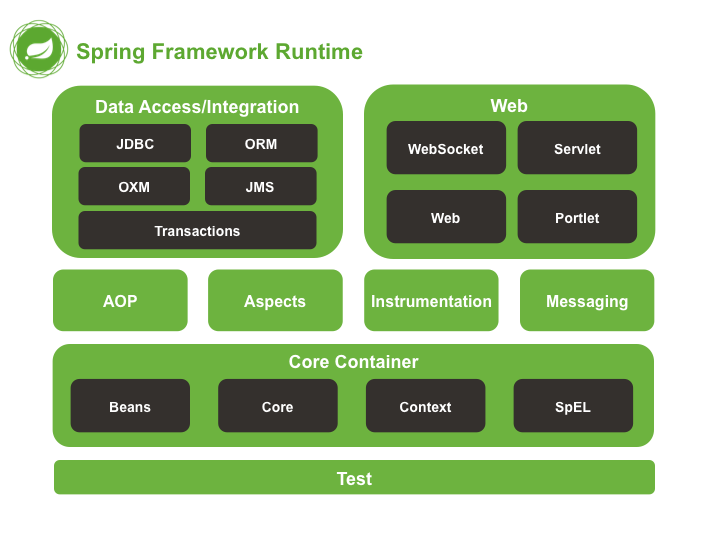Spring-Framework 搭建、基础操作
Spring简介
Spring官网
Spring是一个开源框架,或者说是一个轻量级的容器,为解决企业应用程序开发的复杂性而生。Spring可以针对Bean的生命周期进行管理并且具有良好的分层架构,其核心为IOC(反转控制),采用了AOP(面向切面编程)思想,同时也提供与其他流行的Web应用框架的整合方案,包括Struts2、Hibernate、Mybatis等。
Spring架构

Spring框架搭建
导包

导入约束

创建类
1 | public interface HelloDao { |
1 | public class HelloDaoImpl implements HelloDao { |
设置配置文件
1 | <?xml version="1.0" encoding="UTF-8"?> |
IOC与DI
IOC (Inversion of Control的缩写),即控制反转;DI (Dependency Injection的缩写),即依赖注入。IOC与DI是面向对象编程中的一种设计原则,其作用就是降低代码之间的耦合度,即各个模块之间的关联度。在Java中,代码耦合的根本原因就是使用new 调用构造方法创建对象,如果各个模块之间都使用new的方式来创建其所依赖的对象,将会导致不同模块之间的代码耦合度变高,这就意味着代码的维护和调试成本将被提高。而IOC正是为此而生,所谓控制反转,即由原来各个模块自己创建对象反转为将对象的创建交个一个容器(可以将其理解为一个第三方的机构)帮助我们进行创建和管理,各模块所依赖的对象只需要对容器中创建的对象进行引用即可。依赖注入正是将引用注入到依赖对象中,这样依赖的对象就与容器中的对象产生了关联,最终达到松耦合的目的。Spring框架在设计上也采用了这种设计原则,因此Spring能够很好地帮助我们管理对象以及对象之间的依赖关系。
Spring注解
Spring
@Component(“user”)相当于
@Service:Service层注解
@Controller:Web层注解
@Repository:Dao层注解
@Scope(scopeName=”singleton”)
@Value(“Alibaba”)
@PostConstruct
@PreDestroy
Spring与Junit整合测试
1 | package com.my.junit; |
AOP思想
AOP(Aspect Oriented Programming)即面向切面编程,其主要的作用就是分离程序的业务逻辑与系统级服务(日志、权限认证、事务管理等)。过滤器、拦截器、动态代理都蕴含了AOP思想。
Spring AOP名词
切面(Aspect): 一个关注点的模块化切入点(Pointcut): 匹配连接点的断言。连接点(Joinpoint): 程序在执行过程中某个特定的点通知(Advice): 在切面的某个特定的连接点上执行的动作目标对象(Target Object): 被一个或者多个切面所通知的对象织入(Weaving): 把切面连接到其他的应用程序类型或者对象上,并创建一个被通知的对象引入(Introduction) 在不修改类代码的前提下,为类添加新的方法和属性
通知(Advice)的类型
| 通知类型 | 描述 |
|---|---|
| 前置通知(Before Advice) | 在连接点之前执行的通知,但不能阻止连接点前的执行 |
| 后置通知(After Returning Advice) | 在连接点正常执行完后执行的通知 |
| 后置通知(After finally Advice) | 当连接点退出的时候执行的通知(无论是否出现异常) |
| 环绕通知(Around Advice) | 连接点之前和之后都会执行的通知 |
| 异常通知(After Throwing Advice) | 在方法抛出异常退出时执行的通知 |
Spring Jdbc
Spring Jdbc操作数据库
Spring中整合了Jdbc对数据库操作,在JdbcTemplate类中提供一系列操作数据库的方法,使用JdbcTemplate类对象操作数据库有点类似于QueryRunner,那么如何去使用JdbcTemplate类操作数据库?方法一:在DAO层接口的实现类中声明一个JdbcTemplate对象,并且提供set方法,然后在配置文件对此对象进行注入,并且在配置文件中配置DataSource,因为JdbcTemplate需要通过连接池连接数据库,除此之外还需要将DAO层接口的实现类配置到spring中,那么在需要进行数据库操作的时候,只需要声明一个xxxDao接口对象,将spring配置文件中的配置的xxxDao注入到声明的对象中即可,具体的配置如下:
1 | <?xml version="1.0" encoding="UTF-8"?> |
第二种方法是直接继承JdbcDaoSupport类,JdbcDaoSupport类会根据DataSource自动创建JdbcTemplate类实例,也就是说我们不用再在DAO层手动声明一个JdbcTemplate对象并进行注入,相比上面的方法,这种方法不用再将JdbcTemplate配置spring容器中,而是直接在xxxDaobean中引用dataSource即可
1 | <?xml version="1.0" encoding="UTF-8"?> |
关于配置dataSource,即配置数据库的驱动、连接地址、用户和密码。还有另外一种方式,不是直接在spring中配置,而是将这些信息配置到资源文件中,spring直接从资源文件中读取。
1 | <!-- 指定spring读取properties中的配置 --> |
1 | jdbc.driverClass=com.mysql.cj.jdbc.Driver |
Tips
在xml文件中配置数据库连接地址的时候,后面的参数之间使用&连接,而在properties文件中&符号连接,两者本质上是一样的,前者是转义字符。
Spring事务管理
我们知道,对于不同的数据库平台,其操作的代码的是不一样的,为了解决这个问题,Spring提供一个可针对不同平台进行不同处理的接口PlatformTransactionManager,并且封装了此接口的不同实现,包括JDBCTransactionManager,HibernateTransactionManager,MybatisTransactionManager。

